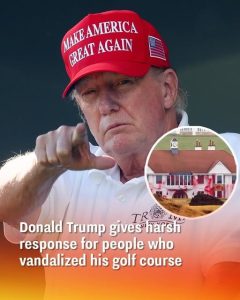Former President Donald Trump’s golf resort in Scotland, Trump Turnberry, was vandalized last month. Red paint was sprayed on the clubhouse, and several putting greens were damaged in what authorities are calling a deliberate act.

Scottish police responded to the incident early on March 8, arriving on the scene around 4:40 a.m.
A 33-year-old man, Kieran Robson, was arrested and charged with malicious mischief. He was released on bail. Two additional suspects—a 75-year-old man and a 66-year-old woman—were also taken into custody but later released pending further investigation.
Trump responded to the incident on his social media platform, condemning the act and calling for those responsible to face serious consequences. He stated that three people were in custody, although police have not officially confirmed all of the arrests.
“This kind of behavior cannot be tolerated,” Trump said, describing the resort as more than just a golf course but a symbol of his personal achievements and dedication. He also praised local law enforcement for their swift action and ongoing efforts.
Following the vandalism, Trump announced increased security measures at Turnberry and said he would continue to work closely with authorities to ensure justice is served.
The incident has reignited debate over the limits of political protest and the lines between free expression and criminal behavior. While critics of Trump may oppose his politics, many agree that damaging private property is not a legitimate form of dissent.
Ultimately, the vandalism at Trump Turnberry underscores the deep political divisions that remain even years after Trump’s presidency. While he continues to command loyalty from supporters, he remains a polarizing figure for others. Still, Trump is clear: he will not allow acts of vandalism—especially those targeting what he considers a personal legacy—to go unanswered.
The investigation remains active as police work to determine the full extent of the damage and identify everyone involved.


